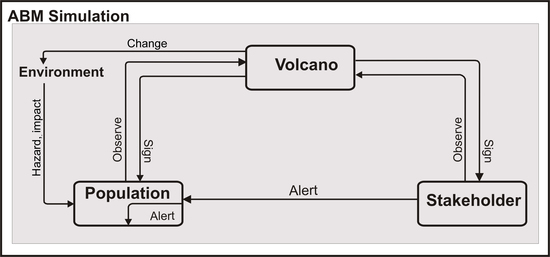A Conceptual Design of Spatio-Temporal Agent-Based Model for Volcanic Evacuation
Abstract
:1. Introduction
2. Spatial Agent-Based Modelling to Support Evacuation Management
3. The Concept of the Volcanic Evacuation Model
3.1. Data Input Requirements
- Administrative boundaries (vector data): this is used to populate the agents within the population unit (district) [120] (see the data in the supplementary material).
- Volcanic hazard zones (vector data): setting up the hazard scenarios and spatial distribution related to the eruption impact.
- Land use (vector data): defining the mean centre of population distribution (see [121]). This data is used to make the distribution of agents spatially similar to the real data.
- Census data: defining the number of agents within each population unit [120].
- Road networks (vector data): this is used for evacuation routing of agent movement. Open Street Map data was used in PBF format for this purpose (see [122]). For the purpose of modelling movement, Dijkstra’s algorithm (see [123]) was utilised to find the shortest path from the origin location to the destination, as this algorithm is advantageous for analysing evacuation routing in a dynamic environment [124].
- Evacuation shelter data (vector data): the shelter is used to accommodate the evacuees. In the initial model, the shelters are placed randomly within the city and outside the hazard zone. It is assumed that people would go to the city, as it will provide much-needed public services. However, a few datasets have been listed that could be used to improve the model in this aspect in future work (see [125,126,127,128,129]).
3.2. Agents and Environment
- Volcano: this is a single agent that can produce activity and influence the hazard zone.
- Stakeholders: represent the authority that has the role of observing the volcano and alerting people.
- People: represent the people who live in the area surrounding the volcano. This agent has the ability to decide to move from the hazard zone to a safe area.
- 4.
- Population unit: this is a fixed environment that is provided as a GIS region. The population unit is provided as the district boundary where the agent’s population will be distributed within this region.
- 5.
- Hazard zones: the hazard zones are provided to express the hazardous environment that is dynamically changing as the volcanic activity is changing.
- 6.
- Route networks: the evacuation routes that are generated using OpenStreetMap (OSM) are a fixed environment that is used by agents to move along.
- 7.
- Evacuation shelters: this is a fixed environment that is distributed outside the hazard zones at GIS points.
3.3. Agent Population Generation
3.4. Agents and Environment Interaction
3.5. Evacuation Decision
- Risk communications deal with the dissemination of risk warning regarding the probability of disaster occurrence within a community. There are three models of interaction in emergency situations, namely vertical (top-down), peer to peer and horizontally broadcast [143]. Communication among people at risk (horizontal communication) is believed to be an effective way to increase the reach of a broadcast. However, the delivering of risk warnings through social interaction also has the potential result of miscoordination [143]. This can lead to the occurrence of congestion and shadow evacuations [144].
- Community and social networks also have an important role to play in influencing people in their responses to a disaster. People tend to follow their group’s (community’s) actions in their decisions in such situations [145]. At the most basic community level, they will tend to stand together with their family when deciding to stay or to leave [146]. It was found by Liu et al. [146] that people in crises will be more easily influenced when they interact with a group rather than with individuals. People may therefore decide to leave after seeing crowds of evacuees leaving their homes. Furthermore, social network contact is relatively more important in influencing evacuation decisions than warnings received from mass media [147].
- Disaster likelihood and/or environmental cues and/or natural signals also influence evacuation decisions [45,147]. Studies of volcano and flood evacuation have identified that natural signals are the most important factors in evacuation decision [147]. Others state that risk perception is associated with environmental cues as well as with the characteristics of the hazard [142].
4. Initial Model Design and Implementation
4.1. Initial Design of the Model
4.2. Potential Use of the Model to Support Evacuation Management
4.2.1. Spatio-Temporal Analysis of the People at Risk Distribution
4.2.2. Analysing the Evacuation Outcome in Different Scenarios
4.2.3. Route Density Analysis
4.2.4. Evacuee Distribution Analysis
4.2.5. Clearance Time Analysis in Different Scenarios
5. Towards a Validation of the Model with Real Data
6. Discussion and Future Work
7. Conclusions
Supplementary Materials
Acknowledgments
Author Contributions
Conflicts of Interest
References
- Lavigne, F.; Thouret, J.C.; Voight, B.; Suwa, H.; Sumaryono, A. Lahars at Merapi volcano, Central Java: An overview. J. Volcanol. Geotherm. Res. 2000, 100, 423–456. [Google Scholar] [CrossRef]
- Voight, B.; Constantine, E.K.; Siswowidjoyo, S.; Torley, R. Historical eruptions of Merapi Volcano, Central Java, Indonesia, 1768–1998. J. Volcanol. Geotherm. Res. 2000, 100, 69–138. [Google Scholar] [CrossRef]
- Newhall, C.G.; Bronto, S.; Alloway, B.; Banks, N.G.; Bahar, I.; del Marmol, M.A.; Hadisantono, R.D.; Holcomb, R.T.; McGeehin, J.; Miksic, J.N.; et al. 10,000 Years of explosive eruptions of Merapi Volcano, Central Java: Archaeological and modern implications. J. Volcanol. Geotherm. Res. 2000, 100, 9–50. [Google Scholar] [CrossRef]
- Mei, E.T.W.; Lavigne, F.; Picquout, A.; de Bélizal, E.; Brunstein, D.; Grancher, D.; Sartohadi, J.; Cholik, N.; Vidal, C. Lessons learned from the 2010 evacuations at Merapi volcano. J. Volcanol. Geotherm. Res. 2013, 261, 348–365. [Google Scholar] [CrossRef]
- Ayuningtyas, D.; Gabriel, L. Respon Masyarakat Terhadap Kebijakan Relokasi Pada Kawasan Rawan Bencana (KRB) (Studi Kasus: Relokasi Desa Glagaharjo); Universitas Gadjah Mada: Yogyakarta, Indonesia, 2013. [Google Scholar]
- Nuzulia, Y.; Sudibyakto, S. Kajian Penolakan Relokasi oleh Warga Terdampak Erupsi Merapi Tahun 2010 (Studi Kasus di Dusun Kalitengah lor, DIYdan Dusun Sambungrejo JawaTengah); Universitas Gadjah Mada: Yogyakarta, Indonesia, 2014. [Google Scholar]
- Mei, E.T.W.; Lavigne, F.; Picquout, A.; Grancher, D. Crisis Management During the 2010 Eruption of Merapi Volcano. In Proceedings of the Regional Geographic Conference—International Geographical Union, Santiago, Chile; 2011; pp. 15–19. [Google Scholar]
- POSKO SET BAKORNAS PBP Penanganan Gunung Merapi: Laporan Posko, 16 June 2006. 2006. Available online: http://118.97.53.73/userfiles/file/buletin/Buletin%20Merapi16.pdf (accessed on 19 March 2015).
- Handayani, D.; Herliansyah, M.K.; Hartono, B.; Sopha, B.M. Community behavior during the evacuation of Mount Merapi eruption disaster. In Proceedings of the 2016 IEEE International Conference on Industrial Engineering and Engineering Management (IEEM), Bali, Indonesia, 4–7 December 2016; pp. 276–280. [Google Scholar]
- De Silva, F.N.; Eglese, R.W. Integrating simulation modelling and GIS: Spatial decision support systems for evacuation planning. J. Oper. Res. Soc. 2000, 51, 423–430. [Google Scholar] [CrossRef]
- Aman, A.; Bakhtiar, T.; Hanum, F.; Supriyo, P.T. OR/MS Applications in Mt. Merapi Disaster Management. J. Math. Stat. 2012, 8, 264–273. [Google Scholar]
- Bachri, S.; Stöetter, J.; Sartohadi, J.; Setiawan, M.A. Evaluation of volcanic risk management in Merapi and Bromo Volcanoes. In Proceedings of the EGU General Assembly Conference Abstracts, Vienna, Austria, 22–27 April 2012; Volume 14, p. 13111. [Google Scholar]
- Bakkour, D.; Enjolras, G.; Kast, R.; Thouret, J. The adaptive governance of natural disasters: Insights from the 2010 Mount Merapi Eruption in Indonesia. Available online: http://www.webcitation.org/6vD8LzkFg (accessed on 24 November 2017).
- Ismayasti, R.; Bakema, M.; Sagala, S. Integrating Disaster Management and Sustainable Development: Finding the Role of NGOs in the Post-Eruption Merapi. 2010. Available online: http://perpustakaan.bappenas.go.id/lontar/file?file=digital/141678-[_TOC_]-Konten%2061-73.pdf (accessed on 26 November 2017).
- Surono, S.; Jousset, P.; Pallister, J. Crisis Management during the centennial 2010 eruption at Merapi volcano, Central Java, Indonesia. In Proceedings of the 2011 International Union of Geodesy and Geophysics (IUGG) General Assembly, Melbourne, Australia, 28 June–7 July 2011. [Google Scholar]
- Jumadi, J.; Suharyadi, R.; Tuladhar, A.M. Web-Based Spatial Information System to Support Collaborative Lahars Disaster Management. Indones. J. Geogr. 2012, 44, 96–144. [Google Scholar]
- Putra, T.Y.D.; Trias, A.; de Vries, W. A Local Spatial Data Infrastructure to Support the Merapi Volcanic Risk Management: A Case Study at Sleman Regency, Indonesia. Indones. J. Geogr. 2011, 43, 25–48. [Google Scholar]
- Schneider, D.J.; Pallister, J.S.; Griswold, J.; Wessels, R.L. Use of satellite remote sensing to support crisis response to the 2010 eruption of Merapi Volcano, Indonesia. AGU Fall Meet. Abstr. 2011, 52, 02. [Google Scholar]
- Setijadji, L.D. Towards an Effective Decision Support System for Merapi Volcano (Yogyakarta Region, Indonesia). In Proceedings of the AGU Fall Meeting Abstracts, American Geophysical Union, San Francisco, CA, USA, 5–9 December 2011; Volume 1, p. 1271. [Google Scholar]
- Andreastuti, S.D.; Alloway, B.V.; Smith, I.E.M. A detailed tephrostratigraphic framework at Merapi Volcano, Central Java, Indonesia: Implications for eruption predictions and hazard assessment. J. Volcanol. Geotherm. Res. 2000, 100, 51–67. [Google Scholar] [CrossRef]
- Charbonnier, S.J.; Gertisser, R. Deposit architecture and dynamics of the 2006 block-and-ash flows of Merapi Volcano, Java, Indonesia. Sedimentology 2011, 58, 1573–1612. [Google Scholar] [CrossRef]
- Charbonnier, S.J.; Gertisser, R. Field observations and surface characteristics of pristine block-and-ash flow deposits from the 2006 eruption of Merapi Volcano, Java, Indonesia. J. Volcanol. Geotherm. Res. 2008, 177, 971–982. [Google Scholar] [CrossRef]
- Gertisser, R.; Cassidy, N.J.; Charbonnier, S.J.; Nuzzo, L.; Preece, K. Overbank block-and-ash flow deposits and the impact of valley-derived, unconfined flows on populated areas at Merapi volcano, Java, Indonesia. Nat. Hazards 2012, 60, 623–648. [Google Scholar] [CrossRef]
- Gomez, C.; Lavigne, F.; Lespinasse, N.; Hadmoko, D.S.; Wassmer, P. Longitudinal structure of pyroclastic-flow deposits, revealed by GPR survey, at Merapi Volcano, Java, Indonesia. J. Volcanol. Geotherm. Res. 2008, 176, 439–447. [Google Scholar] [CrossRef]
- Charbonnier, S.J.; Gertisser, R. Evaluation of geophysical mass flow models using the 2006 block-and-ash flows of Merapi Volcano, Java, Indonesia: Towards a short-term hazard assessment tool. J. Volcanol. Geotherm. Res. 2012, 231, 87–108. [Google Scholar] [CrossRef]
- Darmawan, H.; Wibowo, T.; Suryanto, W.; Setiawan, M. Modeling of pyroclastic flows to predict pyroclastic hazard zone in Merapi volcano after 2010 eruption. In Proceedings of the EGU General Assembly Conference Abstracts, Vienna, Austria, 27 April–2 May 2014; Volume 16, p. 1685. [Google Scholar]
- Itoh, H.; Takahama, J.; Takahashi, M.; Miyamoto, K. Hazard estimation of the possible pyroclastic flow disasters using numerical simulation related to the 1994 activity at Merapi Volcano. J. Volcanol. Geotherm. Res. 2000, 100, 503–516. [Google Scholar] [CrossRef]
- Miyamoto, K.; Gonda, Y.; Yamashita, S.; Matsuyoshi, H. Hazard estimation of the possible pyroclastic flow disasters using numerical simulation related to the 2010 activity at Merapi Volcano, Indonesia. Available online: https://presentations.copernicus.org/EGU2011-12984_presentation.pdf (accessed on 24 November 2017).
- Schwarzkopf, L.M.; Schmincke, H.-U.; Cronin, S.J. A conceptual model for block-and-ash flow basal avalanche transport and deposition, based on deposit architecture of 1998 and 1994 Merapi flows. J. Volcanol. Geotherm. Res. 2005, 139, 117–134. [Google Scholar] [CrossRef]
- Takahashi, T.; Tsujimoto, H. A mechanical model for Merapi-type pyroclastic flow. J. Volcanol. Geotherm. Res. 2000, 98, 91–115. [Google Scholar] [CrossRef]
- Charbonnier, S.J.; Germa, A.; Connor, C.B.; Gertisser, R.; Preece, K.; Komorowski, J.-C.; Lavigne, F.; Dixon, T.; Connor, L. Evaluation of the impact of the 2010 pyroclastic density currents at Merapi volcano from high-resolution satellite imagery, field investigations and numerical simulations. J. Volcanol. Geotherm. Res. 2013, 261, 295–315. [Google Scholar] [CrossRef]
- Yulianto, F.; Sofan, P.; Khomarudin, M.R.; Haidar, M. Extracting the damaging effects of the 2010 eruption of Merapi volcano in Central Java, Indonesia. Nat. Hazards 2013, 66, 229–247. [Google Scholar] [CrossRef]
- Ratdomopurbo, A.; Poupinet, G. An overview of the seismicity of Merapi volcano (Java, Indonesia), 1983–1994. J. Volcanol. Geotherm. Res. 2000, 100, 193–214. [Google Scholar] [CrossRef]
- Ratdomopurbo, A.; Poupinet, G. Monitoring a temporal change of seismic velocity in a volcano: Application to the 1992 eruption of Mt. Merapi (Indonesia). Geophys. Res. Lett. 1995, 22, 775–778. [Google Scholar] [CrossRef]
- Beauducel, F.; Cornet, F.H.; Suhanto, E.; Duquesnoy, T.; Kasser, M. Constraints on magma flux from displacements data at Merapi volcano, Java, Indonesia. J. Geophys. Res. 2000, 105, 8193–8203. [Google Scholar] [CrossRef]
- Pallister, J.S.; Schneider, D.J.; Griswold, J.P.; Keeler, R.H.; Burton, W.C.; Noyles, C.; Newhall, C.G.; Ratdomopurbo, A. Merapi 2010 eruption—Chronology and extrusion rates monitored with satellite radar and used in eruption forecasting. J. Volcanol. Geotherm. Res. 2013, 261, 144–152. [Google Scholar] [CrossRef]
- Voight, B.; Young, K.D.; Hidayat, D.; Purbawinata, M.A.; Ratdomopurbo, A.; Sayudi, D.S.; LaHusen, R.; Marso, J.; Murray, T.L.; Dejean, M. Deformation and seismic precursors to dome-collapse and fountain-collapse nuées ardentes at Merapi Volcano, Java, Indonesia, 1994–1998. J. Volcanol. Geotherm. Res. 2000, 100, 261–287. [Google Scholar] [CrossRef]
- Christia, M. Experiences of People Affected Merapi Eruption in 2010: A Qualitative Study Conducted in Krinjing Village Indonesia. Master’s Thesis, University of Oslo, Oslo, Norway, 2012. [Google Scholar]
- Donovan, K. Cultural Responses to Volcanic Hazards on Mt Merapi, Indonesia; University of Plymouth: Plymouth, UK, 2010. [Google Scholar]
- Donovan, K.; Suryanto, A.; Utami, P. Mapping cultural vulnerability in volcanic regions: The practical application of social volcanology at Mt Merapi, Indonesia. Environ. Hazards 2012, 11, 303–323. [Google Scholar] [CrossRef]
- Dove, M.R. Perception of volcanic eruption as agent of change on Merapi volcano, Central Java. J. Volcanol. Geotherm. Res. 2008, 172, 329–337. [Google Scholar] [CrossRef]
- Lavigne, F.; De Coster, B.; Juvin, N.; Flohic, F.; Gaillard, J.-C.; Texier, P.; Morin, J.; Sartohadi, J. People’s behaviour in the face of volcanic hazards: Perspectives from Javanese communities, Indonesia. J. Volcanol. Geotherm. Res. 2008, 172, 273–287. [Google Scholar] [CrossRef]
- Mei, E.T.W.; Lavigne, F. Influence of the institutional and socio-economic context for responding to disasters: Case study of the 1994 and 2006 eruptions of the Merapi Volcano, Indonesia. Geol. Soc. Lond. Spec. Publ. 2012, 361, 171–186. [Google Scholar] [CrossRef]
- Utami, P. Measuring Social Vulnerability in Volcanic Hazards: The Case Study of Merapi Volcano, Indonesia, Earth Sciences. Master’s Thesis, University of Bristol, Bristol, UK, 2008. [Google Scholar]
- Sagala, S.; Okada, N. F-2 Statistical analysis of correlation between hazard-related factors and households’ evacuation decisions in Mt. Merapi. Proc. Annu. Conf. Inst. Soc. Saf. Sci. 2009, AA12381938, 61–64. [Google Scholar]
- Bignami, C.; Ruch, J.; Chini, M.; Neri, M.; Buongiorno, M.F.; Hidayati, S.; Sayudi, D.S. Surono Pyroclastic density current volume estimation after the 2010 Merapi volcano eruption using X-band SAR. J. Volcanol. Geotherm. Res. 2013, 261, 236–243. [Google Scholar] [CrossRef]
- Charbonnier, S.; Germa, A.; Connor, C.; Connor, L.; Dixon, T.; Komorowski, J.-C.; Gertisser, R.; Lavigne, F.; Preece, K. The 2010 Pyroclastic Density Currents of Merapi Volcano, Central Java, Indonesia. In Proceedings of the EGU General Assembly Conference Abstracts, Vienna, Austria, 7–12 April 2013; Volume 15, p. 6629. [Google Scholar]
- Damby, D.E.; Horwell, C.J.; Baxter, P.J.; Delmelle, P.; Donaldson, K.; Dunster, C.; Fubini, B.; Murphy, F.A.; Nattrass, C.; Sweeney, S.; et al. The respiratory health hazard of tephra from the 2010 Centennial eruption of Merapi with implications for occupational mining of deposits. J. Volcanol. Geotherm. Res. 2013, 261, 376–387. [Google Scholar] [CrossRef] [Green Version]
- De Bélizal, E.; Lavigne, F.; Hadmoko, D.S.; Degeai, J.-P.; Dipayana, G.A.; Mutaqin, B.W.; Marfai, M.A.; Coquet, M.; Le Mauff, B.; Robin, A.-K.; et al. Rain-triggered lahars following the 2010 eruption of Merapi volcano, Indonesia: A major risk. J. Volcanol. Geotherm. Res. 2013, 261, 330–347. [Google Scholar] [CrossRef]
- Mei, E.T.W.; Lavigne, F. Mass evacuation of the 2010 Merapi eruption. Int. J. Emerg. Manag. 2013, 9, 298–311. [Google Scholar] [CrossRef]
- Malleson, N.; See, L.; Evans, A.; Heppenstall, A. Optimising an Agent-Based Model to Explore the Behaviour of Simulated Burglars. In Theories and Simulations of Complex Social Systems; Dabbaghian, V., Mago, V.K., Eds.; Springer: Berlin/Heidelberg, Germany, 2014; Volume 52, pp. 179–204. [Google Scholar]
- Srbljinović, A.; Škunca, O. An Introduction to Agent Based Modelling and Simulation of Social Processes. Interdiscip. Descr. Complex Syst. 2003, 1, 1–8. [Google Scholar]
- Brown, D.G.; Xie, Y. Spatial agent-based modelling. Int. J. Geogr. Inf. Sci. 2006, 20, 941–943. [Google Scholar] [CrossRef]
- Pons, M.; Johnson, P.A.; Rosas, M.; Jover, E. A georeferenced agent-based model to analyze the climate change impacts on ski tourism at a regional scale. Int. J. Geogr. Inf. Sci. 2014, 28, 2474–2494. [Google Scholar] [CrossRef] [Green Version]
- Brown, D.G.; Riolo, R.; Robinson, D.T.; North, M.; Rand, W. Spatial process and data models: Toward integration of agent-based models and GIS. J. Geogr. Syst. 2005, 7, 25–47. [Google Scholar] [CrossRef]
- Jumadi; Carver, S.; Quincey, D. A conceptual framework of volcanic evacuation simulation of Merapi using agent-based model and GIS. Procedia Soc. Behav. Sci. 2016, 227, 402–409. [Google Scholar] [CrossRef]
- Silva, F.N. De Providing spatial decision support for evacuation planning: A challenge in integrating technologies. Disaster Prev. Manag. Bradf. 2001, 10, 11–20. [Google Scholar] [CrossRef]
- Yang, L.; Liu, Q.; Yang, S.-H.; Yu, D. Evacuation Planning with Flood Inundation as Inputs. In Proceedings of the ISCRAM 2015 Conference, Kristiansand, Norway, 24–27 May 2015. [Google Scholar]
- Marrero, J.M.; García, A.; Llinares, A.; De la Cruz-Reyna, S.; Ramos, S.; Ortiz, R. Virtual tools for volcanic crisis management, and evacuation decision support: Applications to El Chichón volcano (Chiapas, México). Nat. Hazards 2013, 68, 955–980. [Google Scholar] [CrossRef]
- Marrero, J.M.; García, A.; Llinares, A.; Rodríguez-Losada, J.A.; Ortiz, R. The Variable Scale Evacuation Model (VSEM): A new tool for simulating massive evacuation processes during volcanic crises. Nat. Hazards Earth Syst. Sci. 2010, 10, 747–760. [Google Scholar] [CrossRef] [Green Version]
- Ye, M.; Wang, J.; Huang, J.; Xu, S.; Chen, Z. Methodology and its application for community-scale evacuation planning against earthquake disaster. Nat. Hazards 2011, 61, 881–892. [Google Scholar] [CrossRef]
- Yang, B.; Ren, B.; Wu, Y. The Research of Multi-Resolution Modeling and Simulation of the Emergency Evacuation. Procedia Eng. 2012, 29, 3110–3116. [Google Scholar] [CrossRef]
- Chen, X.; Meaker, J.W.; Zhan, F.B. Agent-Based Modeling and Analysis of Hurricane Evacuation Procedures for the Florida Keys. Nat. Hazards 2006, 38, 321–338. [Google Scholar] [CrossRef]
- Teo, J.S.; Schmöcker, J.-D.; Leon, F.; Li, J.Y.; Ji, J.; Atanasiu, G.; Taniguchi, E. An Agent-based Evacuation Model Considering Field Effects and Government Advice. Transp. Res. Record J. Transp. Res. Board 2015, 2532, 129–140. [Google Scholar] [CrossRef]
- Tan, L.; Hu, M.; Lin, H. Agent-based simulation of building evacuation: Combining human behavior with predictable spatial accessibility in a fire emergency. Inf. Sci. 2015, 295, 53–66. [Google Scholar] [CrossRef]
- Nagarajan, M. An Operational Research-Based Integrated Approach for Mass Evacuation Planning of a City; Aston University: Birmingham, UK, 2014. [Google Scholar]
- Mas, E.; Suppasri, A.; Imamura, F.; Koshimura, S. Agent-based simulation of the 2011 great east Japan earthquake/tsunami evacuation: An integrated model of tsunami inundation and evacuation. J. Nat. Disaster Sci. 2012, 34, 41–57. [Google Scholar] [CrossRef]
- Handford, D.; Rogers, A. An agent-based social forces model for driver evacuation behaviours. Prog. Artif. Intell. 2012, 1, 173–181. [Google Scholar] [CrossRef]
- Pourrahmani, E.; Delavar, M.R.; Pahlavani, P.; Mostafavi, M.A. Dynamic Evacuation Routing Plan after an Earthquake. Nat. Hazards Rev. 2015, 16, 04015006. [Google Scholar] [CrossRef]
- Pillac, V.; Cebrian, M.; Hentenryck, P.V. A column-generation approach for joint mobilization and evacuation planning. Constraints 2015, 20, 285–303. [Google Scholar] [CrossRef]
- Zia, K.; Ferscha, A. A Simulation Study of Exit Choice Based on Effective Throughput of an Exit Area in a Multi-exit Evacuation Situation. In Proceedings of the Distributed Simulation and Real Time Applications, Singapore, 25–28 October 2009; pp. 235–238. [Google Scholar]
- Dixit, V.V. Hurricane evacuation: Origin, route, and destination. J. Transp. Saf. Secur. 2008, 1, 74–84. [Google Scholar] [CrossRef]
- Lo, S.M.; Huang, H.C.; Wang, P.; Yuen, K.K. A game theory based exit selection model for evacuation. Fire Saf. J. 2006, 41, 364–369. [Google Scholar] [CrossRef]
- Sadri, A.M.; Murray-Tuite, P.; Gladwin, H.; Gladwin, H. Hurricane Evacuation Routing Strategy from Miami Beach: Choice of Major Bridges. Transp. Res. Record: J. Transp. Res. Board 2015, 2532, 164–173. [Google Scholar] [CrossRef]
- Ng, M.; Diaz, R.; Behr, J. Departure time choice behavior for hurricane evacuation planning: The case of the understudied medically fragile population. Transp. Res. Part E Logist. Transp. Rev. 2015, 77, 215–226. [Google Scholar] [CrossRef]
- Zou, N.; Yeh, S.-T.; Chang, G.-L.; Marquess, A.; Zezeski, M. Simulation-Based Emergency Evacuation System for Ocean City, Maryland, During Hurricanes. Transp. Res. Rec. J. Transp. Res. Board 2005, 1922, 138–148. [Google Scholar] [CrossRef]
- Kohsaka, H. Risk prediction and evacuation-rescue plans for pyroclastic flow using GIS: A case study of the southern slope of Asama Volcano, Japan. Geogr. Rev. Jpn. Ser. A 2000, 73, 483–497. [Google Scholar] [CrossRef]
- Brachman, M.L.; Dragicevic, S. A spatially explicit network science model for emergency evacuations in an urban context. Comput. Environ. Urban Syst. 2014, 44, 15–26. [Google Scholar] [CrossRef]
- Goerigk, M.; Deghdak, K.; Heßler, P. A comprehensive evacuation planning model and genetic solution algorithm. Transp. Res. Part E Logist. Transp. Rev. 2014, 71, 82–97. [Google Scholar] [CrossRef]
- Cheng, G.; Wilmot, C.G.; Baker, E.J. A destination choice model for hurricane evacuation. In Proceedings of the 87th Annual Meeting Transportation Research Board, Washington, DC, USA, 13–17 January 2008; pp. 13–17. [Google Scholar]
- Shi, J.; Ren, A.; Chen, C. Agent-based evacuation model of large public buildings under fire conditions. Autom. Constr. 2009, 18, 338–347. [Google Scholar] [CrossRef]
- Christensen, K.; Sasaki, Y. Agent-Based Emergency Evacuation Simulation with Individuals with Disabilities in the Population. Available online: http://jasss.soc.surrey.ac.uk/11/3/9.html (accessed on 17 March 2015).
- Zhao, H.; Winter, S.; Tomko, M. Integrating Decentralized Indoor Evacuation with Information Depositories in the Field. ISPRS Int. J. Geo-Inf. 2017, 6, 213. [Google Scholar] [CrossRef]
- Joo, J.; Kim, N.; Wysk, R.A.; Rothrock, L.; Son, Y.-J.; Oh, Y.; Lee, S. Agent-based simulation of affordance-based human behaviors in emergency evacuation. Simul. Model. Pract. Theory 2013, 32, 99–115. [Google Scholar] [CrossRef]
- Adam, C.; Gaudou, B. Modelling Human Behaviours in Disasters from Interviews: Application to Melbourne Bushfires. J. Artif. Soc. Soc. Simul. 2017, 20, 12. [Google Scholar] [CrossRef]
- Zhang, B. Agent-Based Discrete-Event Simulation and Optimization of Regional Transportation Evacuation. Ph.D. Thesis, Rensselaer Polytechnic Institute, New York, NY, USA, 2012. [Google Scholar]
- Chen, X.; Zhan, F.B. Agent-based modelling and simulation of urban evacuation: Relative effectiveness of simultaneous and staged evacuation strategies. J. Oper. Res. Soc. 2008, 59, 25–33. [Google Scholar] [CrossRef]
- Wang, H.; Mostafizi, A.; Cramer, L.A.; Cox, D.; Park, H. An agent-based model of a multimodal near-field tsunami evacuation: Decision-making and life safety. Transp. Res. Part C Emerg. Technol. 2016, 64, 86–100. [Google Scholar] [CrossRef]
- Usman, F.; Murakami, K.; Wicaksono, A.D.; Setiawan, E. Application of Agent-Based Model Simulation for Tsunami Evacuation in Pacitan, Indonesia. MATEC Web Conf. 2017, 97, 01064. [Google Scholar] [CrossRef]
- Zhang, B.; Chan, W.K.; Ukkusuri, S.V. Agent-based modeling for household level hurricane evacuation. In Proceedings of the 2009 Winter Simulation Conference (WSC), Austin, Texas, 13–16 December 2009; pp. 2778–2784. [Google Scholar]
- Yin, W.; Murray-Tuite, P.; Ukkusuri, S.V.; Gladwin, H. An agent-based modeling system for travel demand simulation for hurricane evacuation. Transp. Res. Part C Emerg. Technol. 2014, 42, 44–59. [Google Scholar] [CrossRef]
- Ukkusuri, S.V.; Hasan, S.; Luong, B.; Doan, K.; Zhan, X.; Murray-Tuite, P.; Yin, W. A-RESCUE: An Agent based regional evacuation simulator coupled with user enriched behavior. Netw. Spat. Econ. 2017, 17, 197–223. [Google Scholar] [CrossRef]
- Bernardini, G.; D’Orazio, M.; Quagliarini, E.; Spalazzi, L. An Agent-based Model for Earthquake Pedestrians’ Evacuation Simulation in Urban Scenarios. Transp. Res. Procedia 2014, 2, 255–263. [Google Scholar] [CrossRef]
- Cimellaro, G.P.; Ozzello, F.; Vallero, A.; Mahin, S.; Shao, B. Simulating earthquake evacuation using human behavior models. Earthq. Eng. Struct. Dyn. 2017, 46, 985–1002. [Google Scholar] [CrossRef]
- Medina, N.; Sanchez, A.; Vojinovic, Z. The Potential of Agent Based Models for Testing City Evacuation Strategies under a Flood Event. Procedia Eng. 2016, 154, 765–772. [Google Scholar] [CrossRef]
- Dawson, R.J.; Peppe, R.; Wang, M. An agent-based model for risk-based flood incident management. Nat. Hazards 2011, 59, 167–189. [Google Scholar] [CrossRef]
- Wise, S. Using Social Media Content to Inform Agent-based Models for Humanitarian Crisis Response; George Mason University: Fairfax, VA, USA, 2014. [Google Scholar]
- Wang, D.Q.; Gong, Q.G.; Shen, X.F. An Improved Personnel Evacuation Cellular Automata Model Based on the Ant Colony Optimization Algorithm. Appl. Mech. Mater. 2014, 513, 3287–3291. [Google Scholar] [CrossRef]
- Yuan, W.; Tan, K.H. An evacuation model using cellular automata. Phys. Stat. Mech. Its Appl. 2007, 384, 549–566. [Google Scholar] [CrossRef]
- Uno, K.; Kashiyama, K. Development of simulation system for the disaster evacuation based on multi-agent model using GIS. Tsinghua Sci. Technol. 2008, 13, 348–353. [Google Scholar] [CrossRef]
- Chen, X. Agent-based micro-simulation of staged evacuations. Int. J. Adv. Intell. Paradig. 2012, 4, 22. [Google Scholar] [CrossRef]
- Hsu, Y.-T.; Peeta, S. An aggregate approach to model evacuee behavior for no-notice evacuation operations. Transportation 2013, 40, 671–696. [Google Scholar] [CrossRef]
- Gilbert, G.N. Agent-Based Models; SAGE: London, UK, 2008; ISBN 978-1-4129-4964-4. [Google Scholar]
- Gilbert, N.; Troitzsch, K. Simulation for The Social Scientist; McGraw-Hill Education: New York, NY, USA, 2005; ISBN 978-0-335-21600-0. [Google Scholar]
- Macal, C.M.; North, M.J. Tutorial on agent-based modeling and simulation. In Proceedings of the 37th conference on Winter simulation, Orlando, FL, USA, 4–7 December 2005; pp. 2–15. [Google Scholar]
- Press, O.U. A Dictionary of Computing; Oxford University Press: Oxford, UK, 2004; ISBN 978-0-19-860877-6. [Google Scholar]
- Demeritt, D.; Wainwright, J. Models, Modelling, and Geography. In Questioning Geography: Fundamental Debates; Blackwell Publishing: Oxford, UK, 2005; p. 206. [Google Scholar]
- Bandyopadhyay, S.; Bhattacharya, R. Discrete and Continuous Simulation: Theory and Practice; CRC Press: Boca Raton, FL, USA, 2014. [Google Scholar]
- Heppenstall, A.; Malleson, N.; Crooks, A. “Space, the Final Frontier”: How Good are Agent-Based Models at Simulating Individuals and Space in Cities? Systems 2016, 4, 9. [Google Scholar] [CrossRef]
- Hawe, G.I.; Coates, G.; Wilson, D.T.; Crouch, R.S. Agent-based simulation for large-scale emergency response: A survey of usage and implementation. ACM Comput. Surv. CSUR 2012, 45, 8. [Google Scholar] [CrossRef] [Green Version]
- Na, H.S.; Banerjee, A. An agent-based discrete event simulation approach for modeling large-scale disaster evacuation network. In Proceedings of the 2014 Winter Simulation Conference, Savannah, GA, USA, 7–10 December 2014; pp. 1516–1526. [Google Scholar]
- Van Dam, K.H.; Bustos-Turu, G.; Shah, N. A methodology for simulating synthetic populations for the analysis of socio-technical infrastructures. In Advances in Social Simulation 2015; Springer: Cham, Switzerland, 2017; pp. 429–434. [Google Scholar]
- Harland, K.; Heppenstall, A.; Smith, D.; Birkin, M. Creating realistic synthetic populations at varying spatial scales: A comparative critique of population synthesis techniques. J. Artif. Soc. Soc. Simul. 2012, 15, 1–15. [Google Scholar] [CrossRef]
- Gilbert, N.; Terna, P. How to build and use agent-based models in social science. Mind Soc. 2000, 1, 57–72. [Google Scholar] [CrossRef]
- Macal, C.M.; North, M.J. Tutorial on agent-based modelling and simulation. J. Simul. 2010, 4, 151–162. [Google Scholar] [CrossRef]
- Macal, C.; North, M. Tutorial on Agent-Based Modeling and Simulation PART 2: How to Model with Agents. In Proceedings of the 2005 Winter Simulation Conference, Orlando, FL, USA, 4–7 December 2005; pp. 73–83. [Google Scholar]
- Sugumaran, R.; DeGroote, J. Spatial Decision Support Systems Principles and Practices; CRC Press: Boca Raton, FL, USA, 2010; ISBN 978-1-4200-6212-0. [Google Scholar]
- Kravari, K.; Bassiliades, N. A Survey of Agent Platforms. J. Artif. Soc. Soc. Simul. 2015, 18, 11. [Google Scholar] [CrossRef]
- Crooks, A.T.; Castle, C.J. The integration of agent-based modelling and geographical information for geospatial simulation. In Agent-Based Models of Geographical Systems; Springer: London, UK, 2012; pp. 219–251. [Google Scholar]
- BPS Kab. Sleman Statistik Daerah Sleman 2015. Available online: http://www.webcitation.org/6vD9mA8gE (accessed on 21 March 2016).
- Jumadi; Carver, S.; Quincey, D. ABM and GIS-based multi-scenarios volcanic evacuation modelling of Merapi. In AIP Conference Proceedings; AIP Publishing: New York, NY, USA, 2016; Volume 1730, p. 050005. [Google Scholar]
- GEOFABRIK Download OpenStreetMap Data for this Region: Indonesia. Available online: http://www.webcitation.org/6t07rwZox (accessed on 26 August 2017).
- Skiena, S. Dijkstra’s algorithm. In Implementing Discrete Mathematics Combination Graph Theory Mathematics Read; MA Addison-Wesley: Boston, MA, USA, 1990; pp. 225–227. [Google Scholar]
- Oyola, A.; Romero, D.G.; Vintimilla, B.X. A Dijkstra-Based Algorithm for Selecting the Shortest-Safe Evacuation Routes in Dynamic Environments (SSER). In Proceedings of the International Conference on Industrial, Engineering and Other Applications of Applied Intelligent Systems; Springer: Cham, Switzerland; 2017; pp. 131–135. [Google Scholar]
- BNPB Peta Lokasi dan Jumlah Pengungsi Letusan G.Api Merapi di Wilayah Kab. Sleman (15 nov). Available online: http://www.webcitation.org/6piPoQCLs (accessed on 14 April 2017).
- BNPB Peta Lokasi dan Jumlah Pengungsi Letusan G.Api Merapi di Wilayah Kab. Bantul (11 nov). Available online: http://www.webcitation.org/6pikQru7D (accessed on 14 April 2017).
- BNPB Peta Lokasi dan Jumlah Pengungsi Letusan G.Api Merapi di Wilayah Kota Yogyakarta (15 nov). Available online: http://www.webcitation.org/6pilvuYiE (accessed on 14 April 2017).
- BNPB Peta Lokasi dan Jumlah Pengungsi Letusan G.Api Merapi di Wilayah Kab. Kulon Progo (15 nov). Available online: http://www.webcitation.org/6piskXxQF (accessed on 14 April 2017).
- Budiyono, A.F. Informasi Posko Pengungsian Merapi DIY (Update 10 November 2010). Available online: http://www.webcitation.org/6pWJmis9R (accessed on 6 April 2017).
- Heppenstall, A.J.; Harland, K.; Smith, D.M.; Birkin, M.H. Creating realistic synthetic populations at varying spatial scales: A comparative critique of population synthesis techniques. In Proceedings of the Geocomputation 2011 Conference Proceedings, UCL, London, UK, 20–22 July 2011; pp. 1–8. [Google Scholar]
- Huang, Z.; Williamson, P. A Comparison of Synthetic Reconstruction and Combinatorial Optimisation Approaches to the Creation of Small-Area Microdata; University of Liverpool: Liverpool, UK, 2001. [Google Scholar]
- BNPB Peta Kawasan Rawan Bencana Merapi. Available online: http://geospasial.bnpb.go.id/wp-content/uploads/2011/05/2011-04-29_KRB_Area_Terdampak_Langsung_Merapi.pdf (accessed on 9 October 2015).
- D’ALBE, E.M.F. Objectives of volcanic monitoring and prediction. J. Geol. Soc. 1979, 136, 321–326. [Google Scholar] [CrossRef]
- Bardintzeff, J.M. Merapi volcano (Java, Indonesia) and Merapi-type nuée ardente. Bull. Volcanol. 1984, 47, 433–446. [Google Scholar] [CrossRef]
- Abdurachman, E.K.; Bourdier, J.-L.; Voight, B. Nuées ardentes of 22 November 1994 at Merapi volcano, Java, Indonesia. J. Volcanol. Geotherm. Res. 2000, 100, 345–361. [Google Scholar] [CrossRef] [Green Version]
- Lavigne, F.; de Bélizal, E.; Cholik, N.; Aisyah, N.; Picquout, A.; Mei, E.T.W. Lahar hazards and risks following the 2010 eruption of Merapi volcano, Indonesia. EGU Gen. Assem. 2011, 13. Available online: http://meetingorganizer.copernicus.org/EGU2011/EGU2011-4400.pdf (accessed on 26 November 2017).
- Lavigne, F.; Thouret, J.-C. Sediment transportation and deposition by rain-triggered lahars at Merapi Volcano, Central Java, Indonesia. Geomorphology 2003, 49, 45–69. [Google Scholar] [CrossRef]
- Thouret, J.-C.; Lavigne, F.; Kelfoun, K.; Bronto, S. Toward a revised hazard assessment at Merapi volcano, Central Java. J. Volcanol. Geotherm. Res. 2000, 100, 479–502. [Google Scholar] [CrossRef]
- Newhall, C.G.; Self, S. The volcanic explosivity index (VEI) an estimate of explosive magnitude for historical volcanism. J. Geophys. Res. 1982, 87, 1231. [Google Scholar] [CrossRef]
- Dash, N.; Gladwin, H. Evacuation Decision Making and Behavioral Responses: Individual and Household. Nat. Hazards Rev. 2007, 8, 69–77. [Google Scholar] [CrossRef]
- Ahsan, M.N.; Takeuchi, K.; Vink, K.; Ohara, M. A Systematic Review of the Factors Affecting the Cyclone Evacuation Decision Process in Bangladesh. J. Disaster Res. 2016, 11, 741. [Google Scholar] [CrossRef]
- Lim, M.B.B.; Lim, H.R.; Piantanakulchai, M.; Uy, F.A. A household-level flood evacuation decision model in Quezon City, Philippines. Nat. Hazards 2015, 80, 1539–1561. [Google Scholar] [CrossRef]
- Linardi, S. Peer coordination and communication following disaster warnings: An experimental framework. Saf. Sci. 2016. [Google Scholar] [CrossRef]
- Lamb, S.; Walton, D.; Mora, K.; Thomas, J. Effect of authoritative information and message characteristics on evacuation and shadow evacuation in a simulated flood event. Nat. Hazards Rev. 2011, 13, 272–282. [Google Scholar] [CrossRef]
- Khalid, M.N.A.; Yusof, U.K. A Crowd Modelling Considering Group Cohesion in the Emergency Route Planning Problems. Aust. J. Basic Appl. Sci. 2014, 8, 33–39. [Google Scholar]
- Liu, S.; Murray-Tuite, P.; Schweitzer, L. Incorporating Household Gathering and Mode Decisions in Large-Scale No-Notice Evacuation Modeling. Comput.-Aided Civ. Infrastruct. Eng. 2014, 29, 107–122. [Google Scholar] [CrossRef]
- Ronald, W. Population Evacuation in Volcanic Eruptions, Floods, and Nuclear Power Plant Accidents: Some Elementary Comparisons. J. Commun. Pschol. 1983, 11, 36–47. [Google Scholar]
- Siebeneck, L.K.; Cova, T.J. Spatial and temporal variation in evacuee risk perception throughout the evacuation and return-entry process. Risk Anal. 2012, 32, 1468–1480. [Google Scholar] [CrossRef] [PubMed]
- Pareschi, M.T.; Cavarra, L.; Favalli, M.; Giannini, F.; Meriggi, A. GIS and volcanic risk management. Nat. Hazards 2000, 26, 361–379. [Google Scholar] [CrossRef]
- Escobar Wolf, R.P. Volcanic Processes and Human Exposure as Elements to Build a Risk Model for Volcan de Fuego, Guatemala; Diss. Michigan Technological University: Michigan, MI, USA, 2013. [Google Scholar]
- Zhang, N.; Huang, H.; Su, B.; Zhang, H. Population evacuation analysis: Considering dynamic population vulnerability distribution and disaster information dissemination. Nat. Hazards 2013, 69, 1629–1646. [Google Scholar] [CrossRef]
- Huang, Z.; Zheng, P.; Ren, G.; Cheng, Y.; Ran, B. Simultaneous optimization of evacuation route and departure time based on link-congestion mitigation. Nat. Hazards 2016, 83, 575–599. [Google Scholar] [CrossRef]
- Liu, X.; Lim, S. Integration of spatial analysis and an agent-based model into evacuation management for shelter assignment and routing. J. Spat. Sci. 2016, 61, 1–16. [Google Scholar] [CrossRef]
- Yi, W.; Özdamar, L. A dynamic logistics coordination model for evacuation and support in disaster response activities. Eur. J. Oper. Res. 2007, 179, 1177–1193. [Google Scholar] [CrossRef]
- Mitchell, S.; Radwan, E. Heuristic Priority Ranking of Emergency Evacuation Staging to Reduce Clearance Time. Transp. Res. Rec. J. Transp. Res. Board 2006, 1964, 219–228. [Google Scholar] [CrossRef]
- Tu, H.; Tamminga, G.; Drolenga, H.; de Wit, J.; van der Berg, W. Evacuation plan of the city of almere: simulating the impact of driving behavior on evacuation clearance time. Procedia Eng. 2010, 3, 67–75. [Google Scholar] [CrossRef]
- Lavigne, F.; Morin, J.; Mei, E.T.W.; Calder, E.S.; Usamah, M.; Nugroho, U. Mapping Hazard Zones, Rapid Warning Communication and Understanding Communities: Primary Ways to Mitigate Pyroclastic Flow Hazard. In SpringerLink; Advances in Volcanology; Springer: Berlin/Heidelberg, Germany, 2017; pp. 1–13. [Google Scholar]
- Sagala, S.A.H. System Analysis of Social Resilience against Volcanic Risks Case Studies of Merapi, Indonesia and Mt. Sakurajima, Japan; Kyoto University: Kyoto, Japan, 2009. [Google Scholar]
- Van Drimmelen, M.N. Family Gathering in Evacuations: A Case-Study of the 2007 Angora Fire; The University of Utah: Salt Lake City, UT, USA, 2010. [Google Scholar]
- Wilson, T.; Dantas, A.; Cole, J. Livestock Evacuation or Not: An Emergency Response Assessment of Natural Disasters. Proc. East Asia Soc. Transp. Stud. 2009, 7, 8. [Google Scholar]
- Local Government of Sleman Pemerintah Kabupaten Sleman Update Data Pengungsi Bencana Merapi. 2010. Available online: http://www.webcitation.org/6pNWR8K4a (accessed on 31 March 2017).
- Klügl, F. A Validation Methodology for Agent-based Simulations. In Proceedings of the 2008 ACM Symposium on Applied Computing, Fortaleza, Ceara, Brazil, 16–20 March 2008; ACM: New York, NY, USA, 2008; pp. 39–43. [Google Scholar]
- Dixit, V.; Montz, T.; Wolshon, B. Validation techniques for region-level microscopic mass evacuation traffic simulations. Transp. Res. Rec. J. Transp. Res. Board 2011, 2229, 66–74. [Google Scholar] [CrossRef]
- Siebert, L.; Simkin, T.; Kimberly, P. Volcanoes of the World; University of California Press: Berkeley, CA, USA, 2011. [Google Scholar]
- Anderson, W.A. Disaster Warning and Communication Processes in Two Communities. J. Commun. 1969, 19, 92–104. [Google Scholar] [CrossRef] [PubMed]
- Durage, S.W.; Wirasinghe, S.C.; Ruwanpura, J.Y. Decision Analysis for Tornado Warning and Evacuation. Nat. Hazards Rev. 2016, 17, 04015014. [Google Scholar] [CrossRef]
- Baker, E.J. Hurricane evacuation behavior. Int. J. Mass Emerg. Disasters 1991, 9, 287–310. [Google Scholar]
- Lovreglio, R.; Borri, D.; Ronchi, E.; Fonzone, A.; dell’Olio, L. The need of latent variables for modelling decision-making in evacuation simulations. In Proceedings of the IX International Workshop on Planning and Evaluation, Bari, Italy, 16–18 March 2015. [Google Scholar]
- Lovreglio, R.; Ronchi, E.; Nilsson, D. An Evacuation Decision Model based on perceived risk, social influence and behavioural uncertainty. Simul. Model. Pract. Theory 2016. [Google Scholar] [CrossRef]
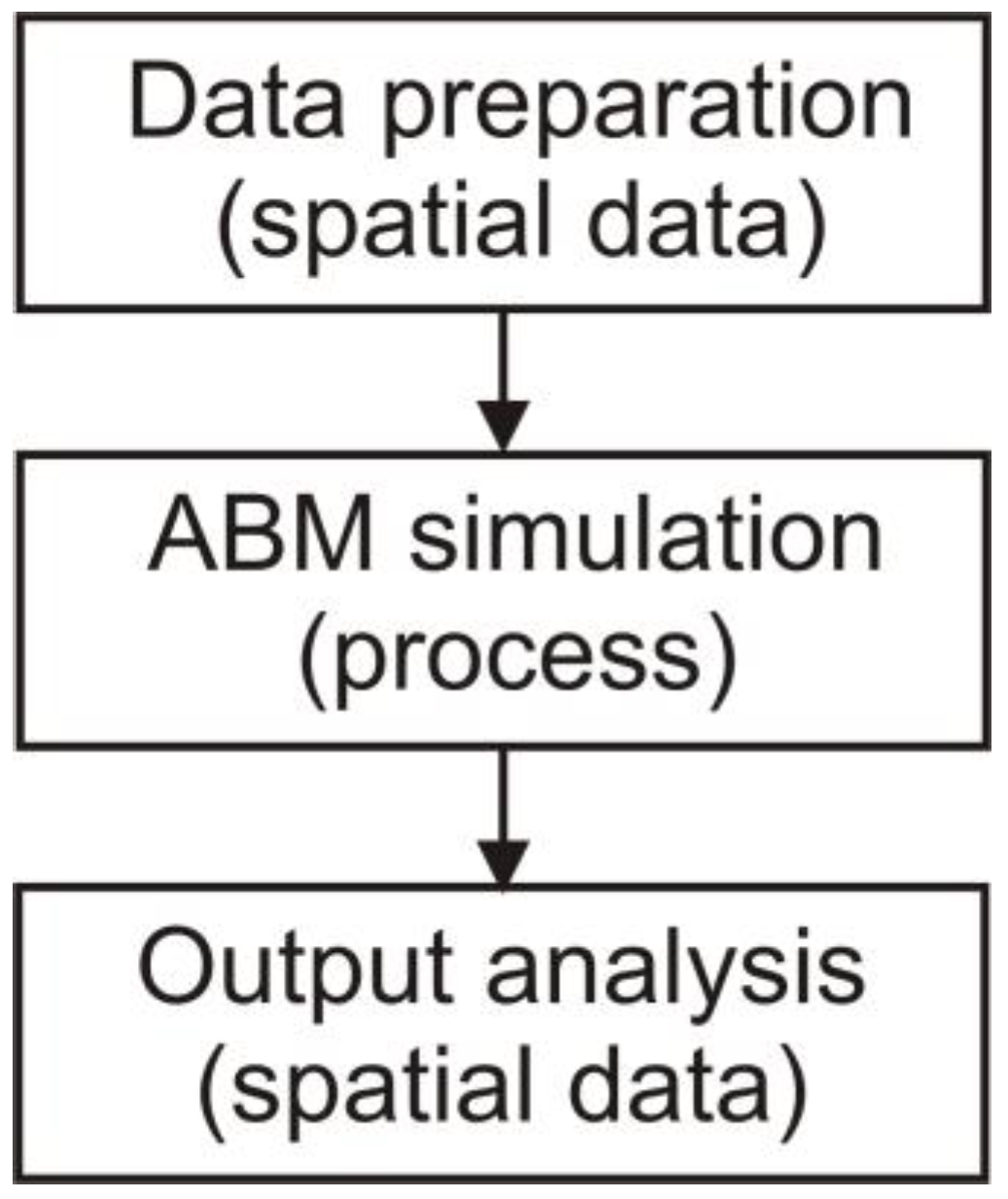
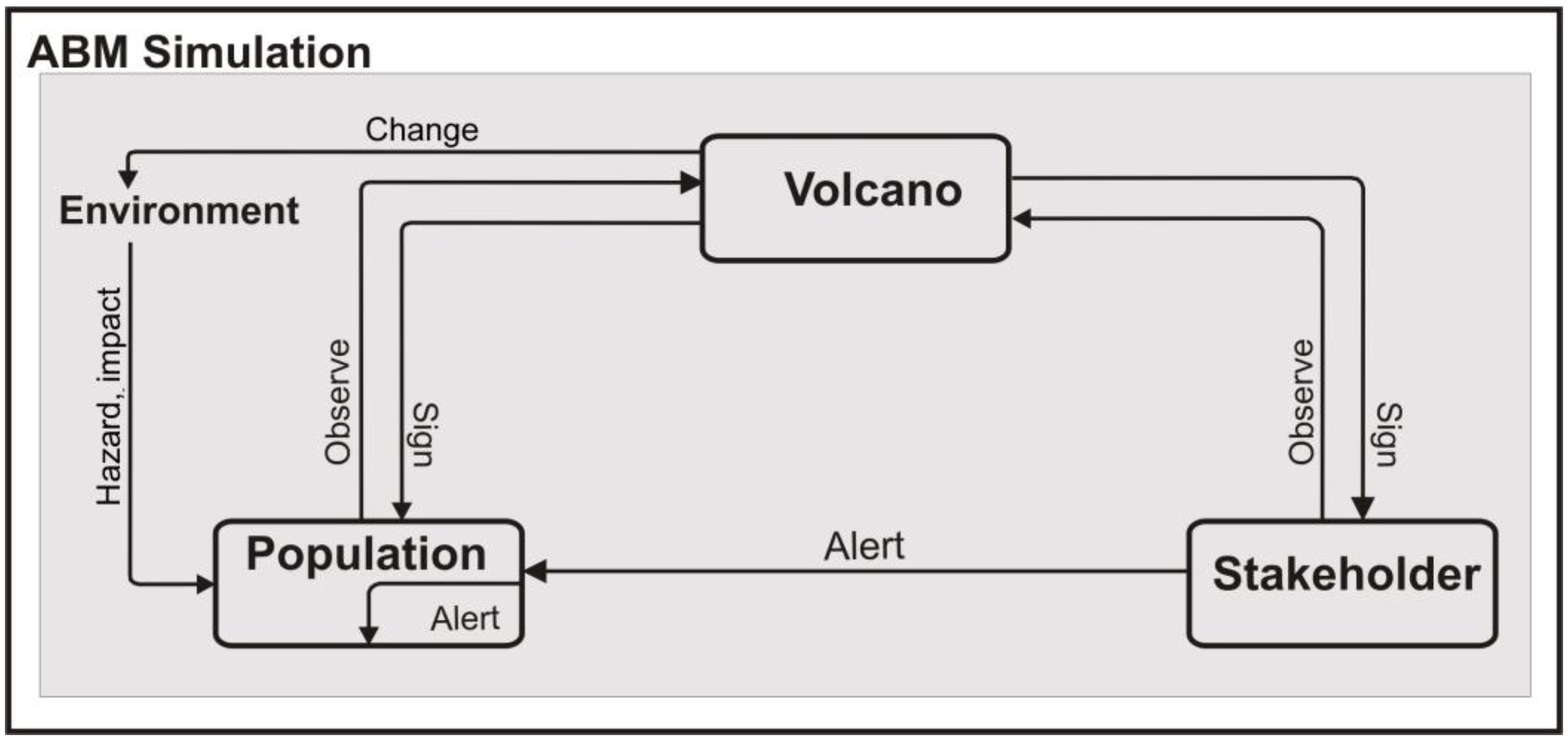
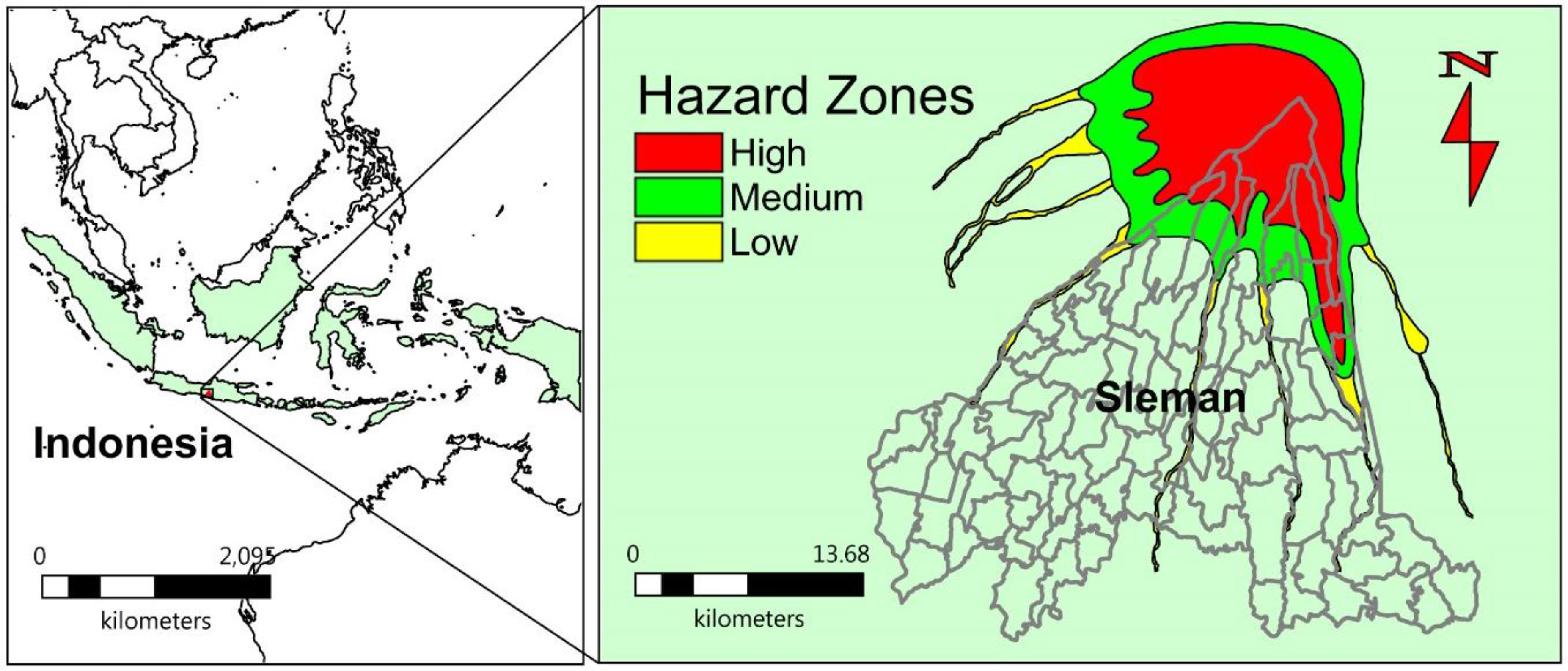



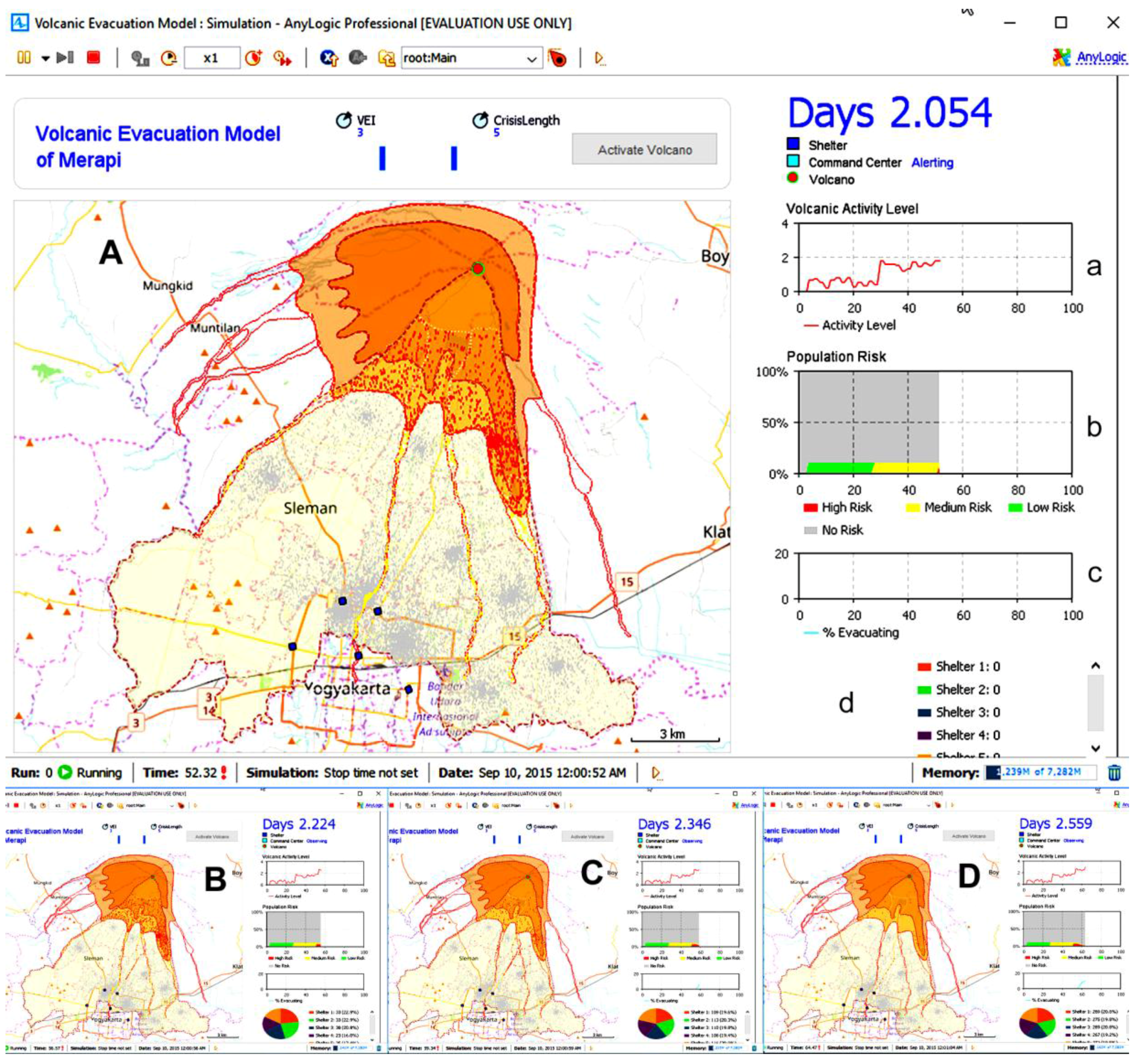
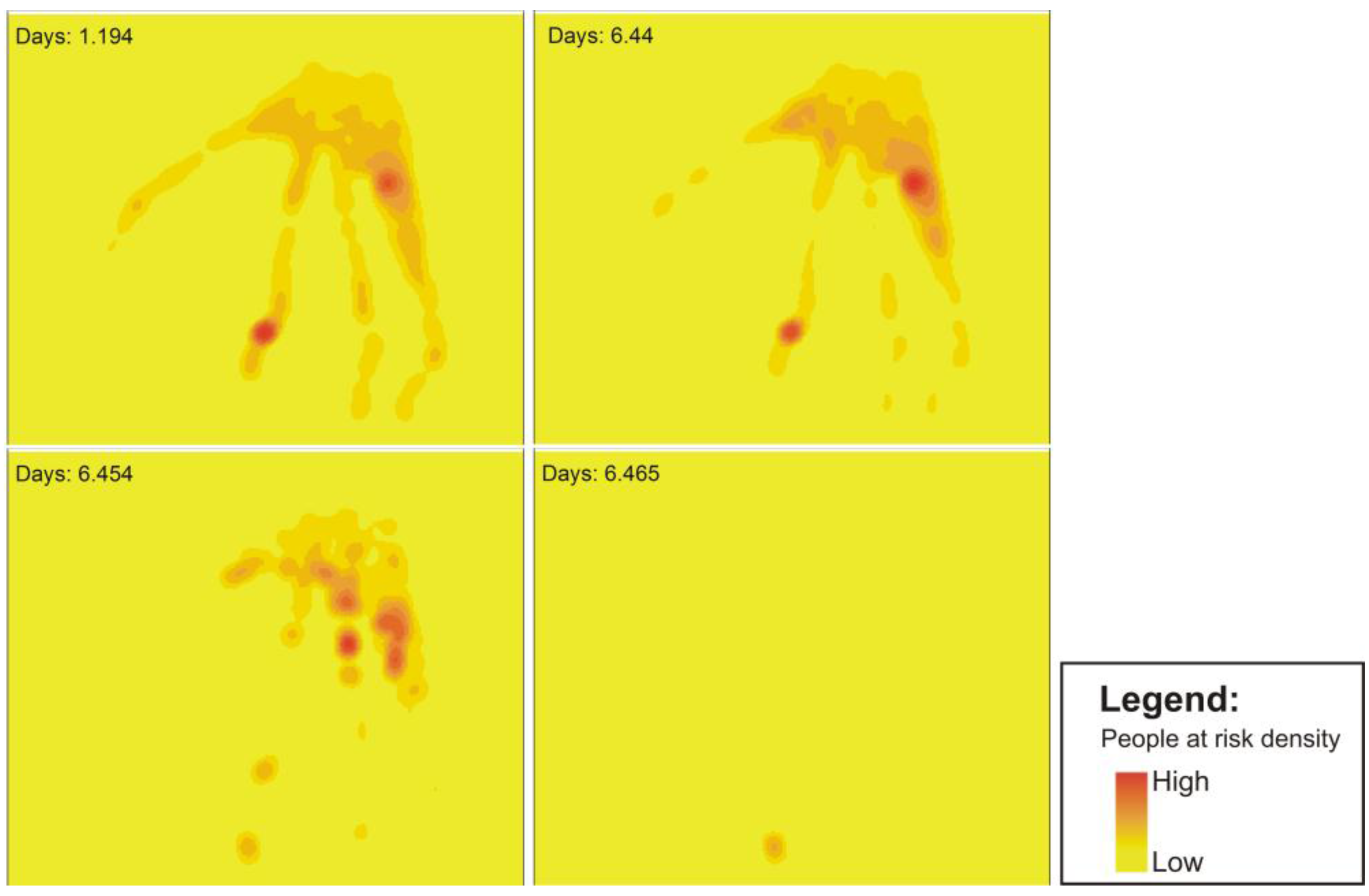

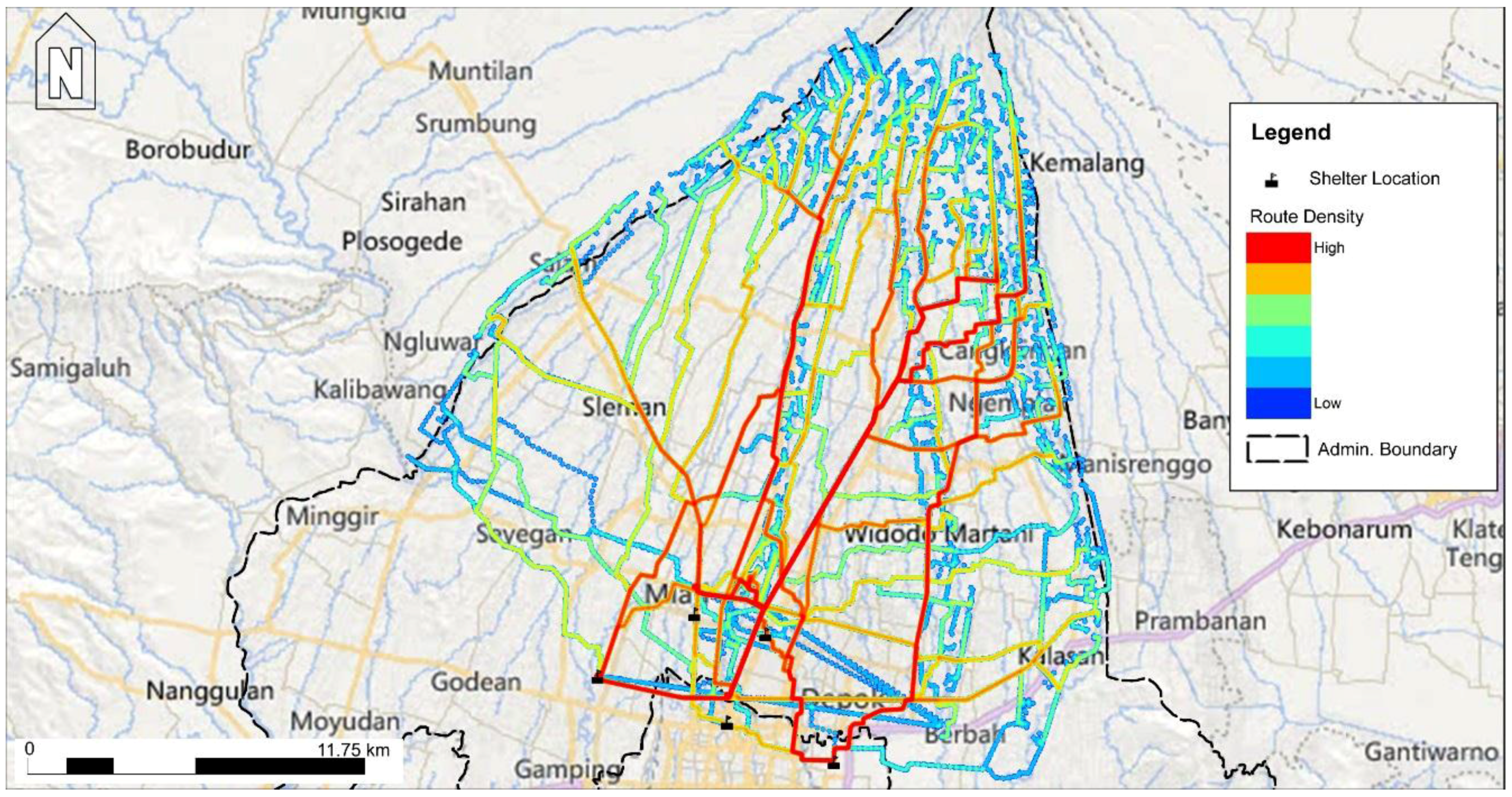
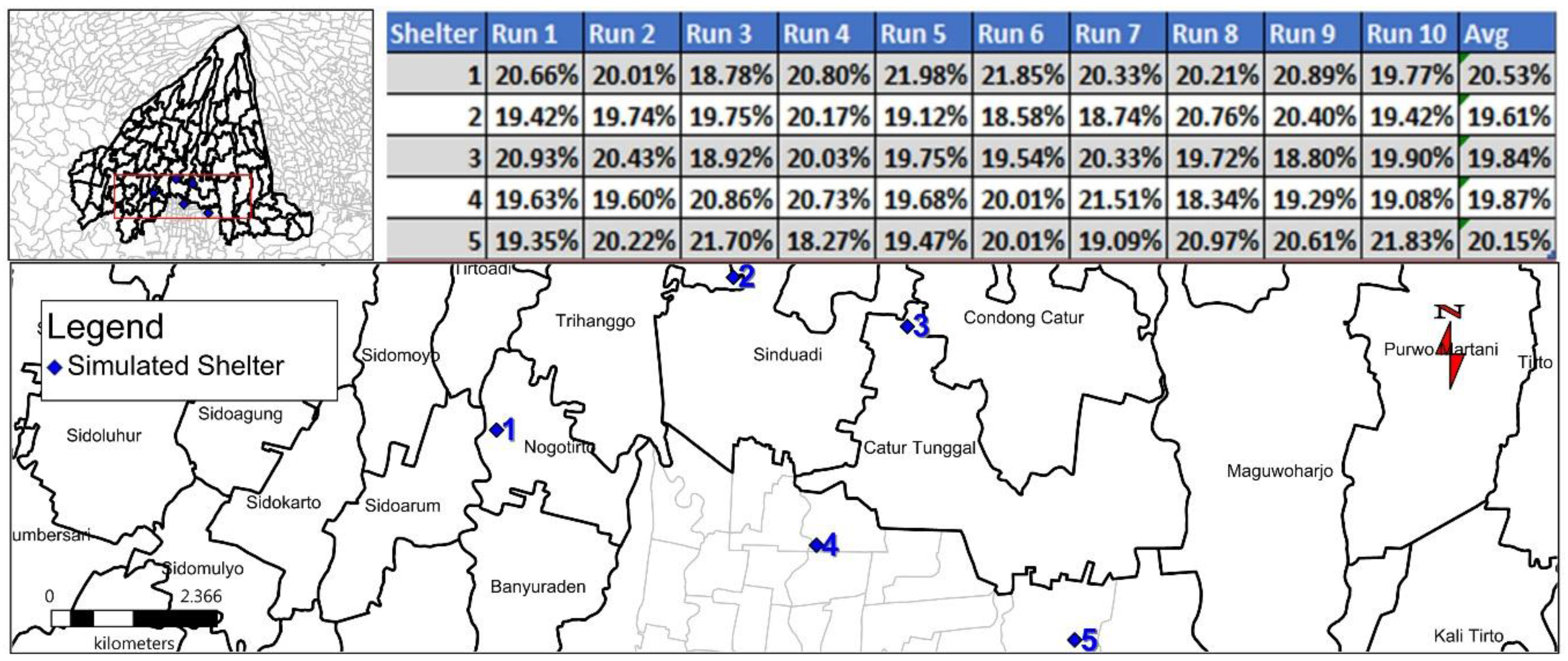

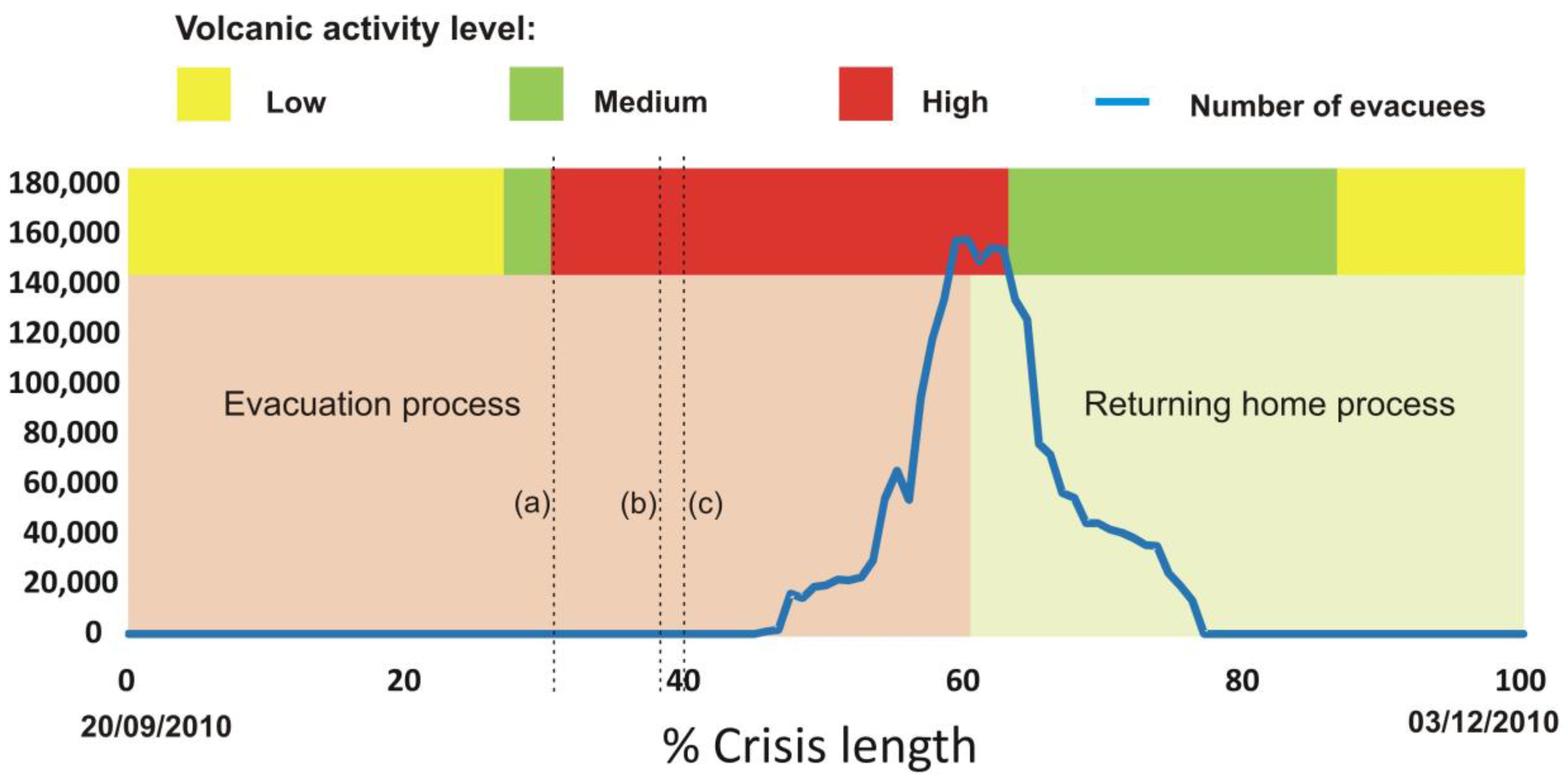
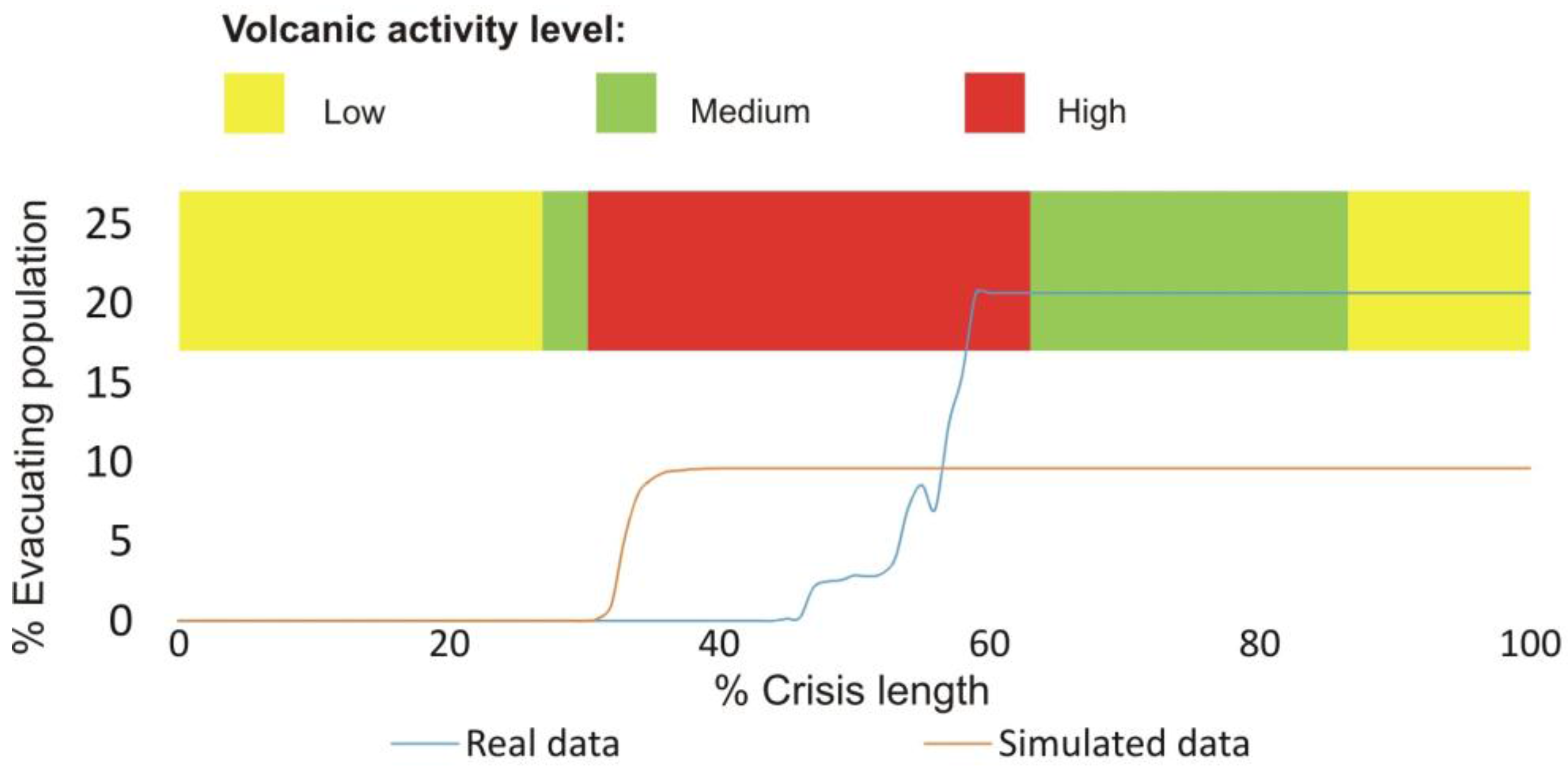
| No. | Research Focus | References |
|---|---|---|
| 1 | Disaster/risk management | [7,11,12,13,14,15] |
| 2 | Decision support for disaster/crisis management | [16,17,18,19] |
| 3 | Historical events | [2,3,20] |
| 4 | Sediment/deposit characteristics | [21,22,23,24] |
| 5 | Hazard mapping/modelling | [25,26,27,28,29,30] |
| 6 | Impact of eruption | [30,31,32] |
| 7 | Seismicity | [33,34] |
| 8 | Activity monitoring | [35,36,37] |
| 9 | Population response, characteristics, perception and vulnerability | [38,39,40,41,42,43,44] |
| 10 | Factors influencing evacuation decision | [9,45] |
| 11 | Hazard characteristics | [46,47,48,49] |
| 12 | Lessons from past evacuation management | [4,50] |
| Modelling Type and Method | Hazard |
|---|---|
| Macroscopic | |
| Agent-Based Model | Hurricane [76] |
| Geographic Information System | Volcanic [59,60,77]; Earthquake [61] Generic hazard [78] |
| Mathematical/numerical model | Earthquake [69]; Generic hazard [70]; |
| Genetic algorithm | Generic hazard [79]; Flood [58] |
| Discrete choice | Hurricane [80] |
| Mesoscopic | |
| ABM and numerical simulation | Tsunami [64] |
| Linear programming | Hurricane [72] |
| Microscopic | |
| Agent-Based Model | Fire/building-damage-related hazard [65,81,82,83,84,85]; Generic hazard [66,86,87]; Tsunami [67,88,89]; Hurricane [63,68,90,91,92]; Earthquake [93,94]; Flood [95,96] Wildfire [97] |
| Cellular automata | Generic hazard [71,98]; Fire [99] |
| Dijkstra’s algorithm, virtual reality Visualisation | Flood [100] |
| Particle swarm optimization algorithm | Generic hazard [62] |
| Game theory | Fire [73] |
| Micro-simulation | Generic hazard [101] |
| Mixed logit | Terror attack [102] |
| Entity | Attribute Name | Attribute Type | Description |
|---|---|---|---|
| Volcano | Latitude | Double | Latitude of the volcano location |
| Longitude | Double | Longitude of the volcano location | |
| Activity length | Integer | The duration of crisis | |
| Activity level | Double | This represents the level of volcanic activity expressed qualitatively from low (1) to high (4) | |
| VEI | Volcanic Explosivity Index | ||
| Activity Scenarios | List<double> | Contains the list of the scenarios of activity length of each level (low to high) | |
| People | District ID | Integer | Number of districts where people live |
| Latitude | Double | Latitude of current location | |
| Longitude | Double | Longitude of current location | |
| Home latitude | Double | Latitude of home location | |
| Home longitude | Double | Longitude of home location | |
| Movement speed | Double | Speed of movement (km/h) | |
| Hazard level | Integer | The hazard level of the agent location | |
| Destination | Shelter | The selected destination for evacuation | |
| Links | List<People> | List of people generated randomly to express agents’ relationship | |
| Age | Integer | Age of person generated from custom distribution based on census data | |
| Education | Integer | Education level of person generated from custom distribution based on census data | |
| Sex | Integer | Gender (male = 1, female = 2) of person generated from custom distribution based on census data | |
| Stakeholder | Alert level | Integer | Alert level as a result of volcanic activity observation |
| Links | List<People> | List of random people who directly receive the alert | |
| Environment | Districts | List<Polygon> | The boundaries of districts (polygon) |
| Hazard zone | List<Polygon> | The hazard zones (see Figure 1) | |
| Shelters | List<Point> | Location of shelters as evacuation destinations | |
| Routes | List<Object> | Routes where people are moving loaded from OSM |
| VEI | 1 | 2 | 3 | 4 | |
|---|---|---|---|---|---|
| Zone | |||||
| High | High | High | High | High | |
| Medium | Medium | Medium | High | High | |
| Low | Low | Low | Low | Low | |
| Activity | Low | Medium | High | |
|---|---|---|---|---|
| Zone | ||||
| Low | Low | Low | Low | |
| Medium | Low | Medium | Medium | |
| High | Low | Medium | High | |
© 2017 by the authors. Licensee MDPI, Basel, Switzerland. This article is an open access article distributed under the terms and conditions of the Creative Commons Attribution (CC BY) license (http://creativecommons.org/licenses/by/4.0/).
Share and Cite
Jumadi; Carver, S.; Quincey, D. A Conceptual Design of Spatio-Temporal Agent-Based Model for Volcanic Evacuation. Systems 2017, 5, 53. https://doi.org/10.3390/systems5040053
Jumadi, Carver S, Quincey D. A Conceptual Design of Spatio-Temporal Agent-Based Model for Volcanic Evacuation. Systems. 2017; 5(4):53. https://doi.org/10.3390/systems5040053
Chicago/Turabian StyleJumadi, Steve Carver, and Duncan Quincey. 2017. "A Conceptual Design of Spatio-Temporal Agent-Based Model for Volcanic Evacuation" Systems 5, no. 4: 53. https://doi.org/10.3390/systems5040053






